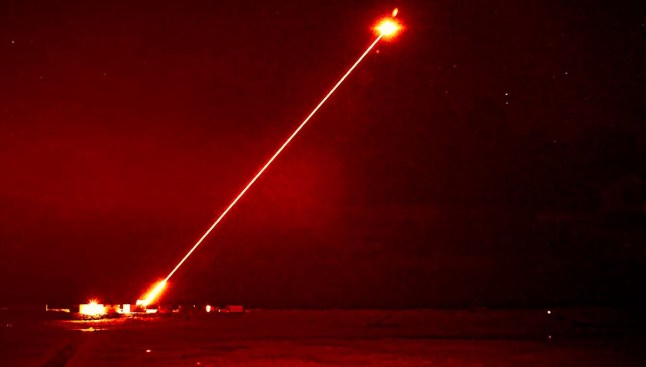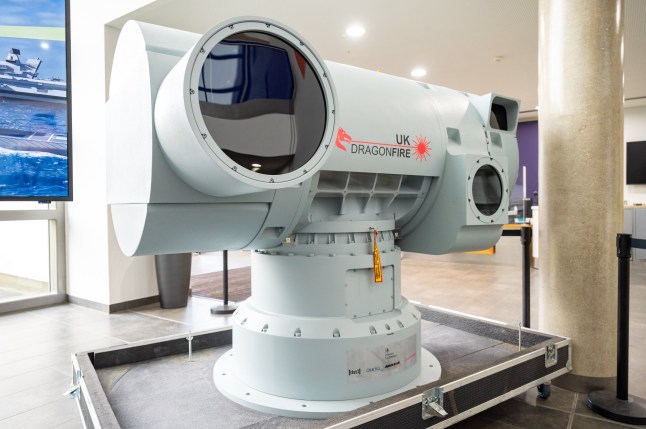To view this video please enable JavaScript, and consider upgrading to a web
browser that
supports HTML5
video
The Royal Navy will install four new cutting-edge weapons systems on its warships to help defend against air attacks from Russia and the Houthis.
Yesterday Chancellor Rachel Reeves announced in the Spring Statement that defence spending will increase to 2.5% of GDP – and some of that extra cash will go towards four DragonFire direct energy weapons.
The weapons shoot a laser of pure heat at its targets, either destroying them or seriously damaging missile guidance systems.
And they’re so accurate they could hit a target the size of a £1 coin from 0.6miles (1km) away.
It’s hoped the weapons will improve the defence capabilities of the UK Navy – boosting our capabilities both against potential threats from Russia and ongoing attacks from Houthis in the Red Sea.
Dr Sidharth Kahsual, a senior research fellow at the Royal United Services Institute (RUSI), told Metro: ‘What DragonFire provides is a low cost per shot capability that fills an intermediate space between surface to air missiles, which cover many tens of kilometres, and close range weapons on a ship, which are often a last resort.

‘It’s quite power consuming, which is something the Navy will have to work around, but vessels have huge power plants anyway and their power generators have enormous output.’
The DragonFire ‘death laser’ comes to life after the ship’s radar detects an incoming threat such as a missile or drone. DragonFire will then target and track its path, before shooting it down with a 55kilowatt laser which burns a hole through it.
It hasn’t yet been confirmed which Navy ships will be fitted with the new weapon, but it’s thought four of our six Type 45 destroyers will receive them, with the HMS Queen Elizabeth and HMS Prince of Wales potentially receiving them at a later date, MailOnline reports.
The direct energy weapons are ‘certainly’ an area of interest for navies around the world, Dr Kashual said, adding that the US Navy has recently trialed similar weapons.
He explained that these types of weapon have a ‘high performance for its output’ and are ‘pretty cleverly engineered’.

One major bonus of the DragonFire system is that it is powered using existing power systems already located on board.
This means it doesn’t need expensive ammo, costing only about £10 to fire, and reduces how often a ship needs to dock to receive more ammo for conventional weapons.
Dr David Blagden is associate professor in international security and strategy at the University of Exeter. He told Metro that DragonFire does have its limits.
‘Lasers rely on direct line-of-sight, can be impeded by things like smoke or vapour, might be countered by incoming weapons’ own heat shielding, and will need to be aimed quickly and accurately enough by a sufficiently advanced targeting radar,’ he explained.
‘But DragonFire can be a valuable complement to such air defence missiles and guns, unencumbered by the same scarcity constraints, particularly for defending against things like drone swarms, where each incoming munition is not especially fast or capable by itself, but where adversaries may try to swamp traditional air defence missiles and guns with the sheer number of attack drones.’

Before the Spring Statement, the Ministry of Defence (MoD) had only committed to installing one prototype DragonFire on a single ship.
It’s hoped the new weapons will be able to cheaply and efficiently destroy cheap drones or missiles, such as those used by the Houthis, at a much lower cost – saving resources in case of escalation of the war in Ukraine.
‘Russia relies quite heavily on missile attacks to hold stronger navies at arm’s length, so this improvement of air missile defence represents something of a challenge for them,’ Dr Kahsual explained.
‘Some of the weapons used by Russia tend to be designed to overwhelm defence by brute force, their speed leaves little time to react, so DragonFire doesn’t fundamentally change that.
‘Where it becomes more useful is second tier situations like the Houthis in the Red Sea where everybody is relatively constrained.
‘The most important impact of DragonFire will be in places like the Red Sea that doesn’t draw down resources in the EU.’
Get in touch with our news team by emailing us at webnews@metro.co.uk.
For more stories like this, check our news page.